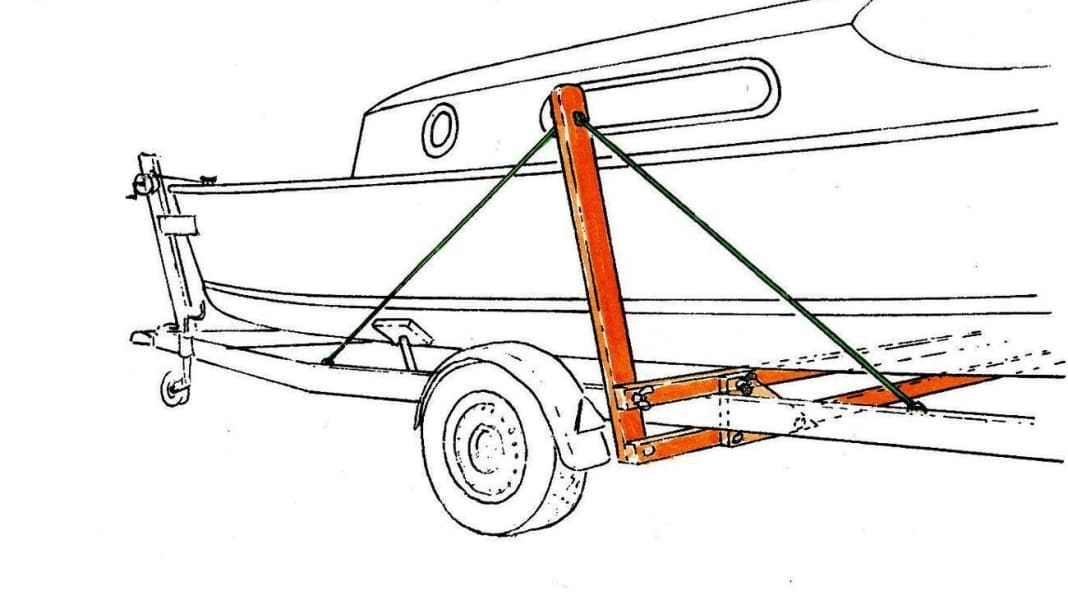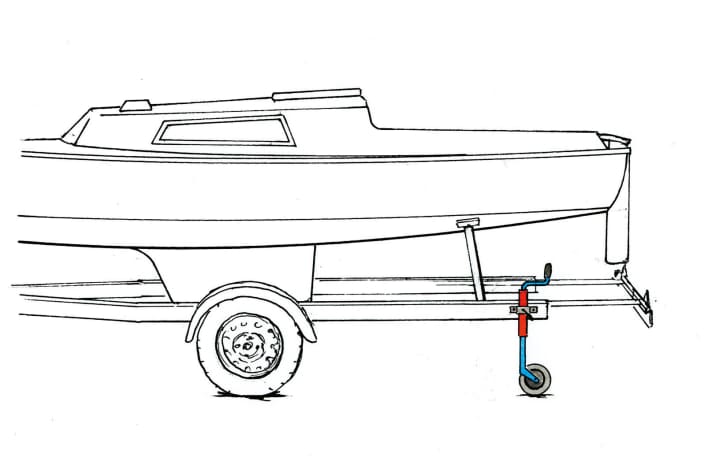
Rolling anti-tip device
Single-axle trailers in particular are sometimes a little tippy. Normally, the drawbar load may only be 75 kilograms. If the trailered boat is then untensioned, for example to fit the outboard motor before slipping or to clear something in the cockpit, there is an acute risk of tipping - so the trailer should be supported at the rear. To avoid always having to carry a support, we have bolted a second drawbar wheel to the rear. This means that the trailer can be quickly secured against tipping at any time and can still be manoeuvred easily, at least on level ground.
Wilfried Korff, Düsseldorf

Centring aid 1
A method of fixing the boat in the centre of the trailer when driving onto it: We simply use lines that are attached to the roller supports of the trailer. So that they can be found in the water, we tie fenders to them as buoyancy aids, but they can also be empty bottles or any other floating objects. Once the boat has been placed over the trailer, the lines are taken on board and the stern is manoeuvred onto the trailer's rollers by pulling on one end or the other. If necessary, you can even use the winches to help carefully. If clamps are fitted within reach, for example for the mainsheet, the lines can be secured in these and are easy to readjust. By the way: Lines attached far aft on the hanger can also help when slipping off. When guided to the winches via bow or spring cleats, the lines can be pulled aft until the boat floats freely.
Philine Peschke, Hamburg | Photo: J. Peschke

This article is part of a trailer special:
Clutch aid
If no second person is available to guide you when coupling the trailer, and if there is no reversing camera or other aids such as trailer aerials, the bumper is quickly scratched. We have therefore fitted a mirror from the motorhome accessories to the extension of the winch stand. Now the driver has a good view of the coupling bell when manoeuvring and can steer the trailer precisely even without a guide.
Wilfried Korff, Düsseldorf | Photo: J. Peschke

Support with mast positioning
We raise the mast using the trailer's winch when the boat is still on the trailer. The wire rope of the winch is connected to the forestay and guided over the anchor roller at the bow. Thanks to the high gear ratio, the mast can be raised in a controlled manner, requiring only a helper for lateral support. As soon as the lower shrouds are taut, this is no longer necessary and the backstay and upper shrouds can be attached. This method is also practical and safe when laying the mast.
Ortwin Arz, Memmingerberg

Double nose wheel
To prevent the trailer from sinking into sand or gravel, we built a double wheel. The crank and the outer tube of a second front wheel were unscrewed, followed by the solid rubber wheel and axle. The extended axle was attached with two adjusting rings instead of the original, the wheelbarrow wheels were pushed on to the right and left and attached with adjusting rings - done! This "aeroplane landing gear" is simply replaced with the standard nose wheel for slipping.
Andreas Heilmann, Borsdorf | Photo: J. Peschke

Centring aid 2
It is sometimes difficult to get the boat centred on the trailer when slipping; it is all too easy for the hull to drift at the last moment and sit at an angle on the supports. To prevent this, we have built a wooden subframe. The construction is attached to the hanger so that it is positioned just before the widest part of the hull. Two lines stabilise it against folding over. Now the boat can no longer break out sideways when swimming in.
Philine Peschke, Hamburg | Photo: J. Peschke

Centring aid 3
To prevent our boat from drifting away in the current or wind when slipping, we made a guide from wheelbarrow wheels to keep the keel centred on the trailer. Because welding it to the trailer would also require a new TÜV approval, we came up with a variant using clamps. The vertical axle on which the wheel sits was welded to the end of a vertical plate. We attached this plate to the struts of the trailer using square clamps. Assembly is very simple and the wheels ensure that the boat can still be moved easily.
Norbert Franzke, Krefeld


